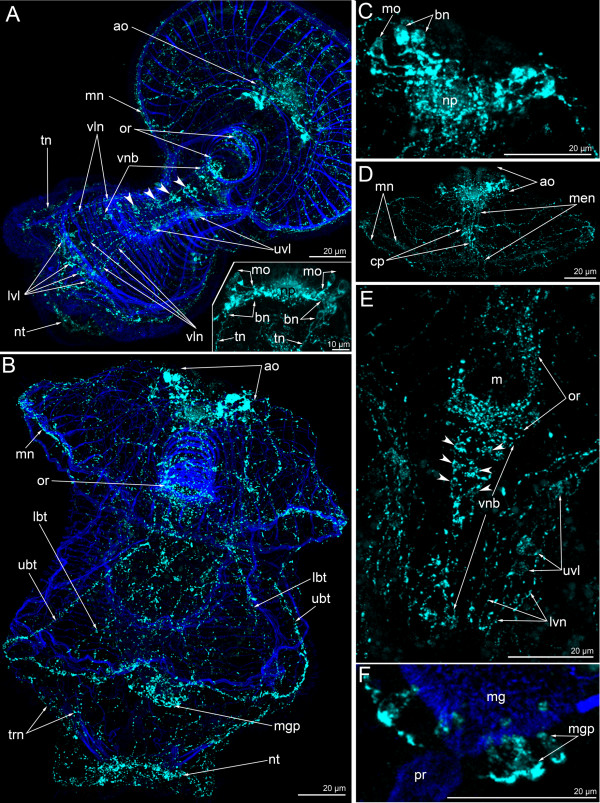Figure 12.
Organization of the FMRFamide-like immunoreactive nervous system in 13-day-old (A, A-insert) and 24-day-old (B-F) larvae, respectively. Z-projections of larvae after mono- and double staining with antibodies against FMRFamide (cyan), as well as staining with phalloidin (blue). Apical is to the top in all cases except for A, where it is to the upper right. (A) Overview of the musculature and FMRFamide-like immunoreactive nervous system showing apical organ (ao), marginal neurite bundle (mn), oral ring (or), ventral neurite bundles (paired perikarya are shown by arrowheads), upper ventro-lateral perikarya (uvl), ventro-lateral neurites (vln), lower ventro-lateral perikarya (lvl), tentacular neurite bundle (tn), and neurites of the telotroch (nt). Ventral view. (A-insert) Apical organ with two groups of monopolar perikarya (mo) and bipolar or multipolar perikarya (bn) that give rise to the tentacular neurite bundle (tn). Dorsal view. (B) Overview showing apical organ (ao), marginal neurite bundle (mn), oral ring (or), upper branch of the tentacular neurite bundle (ubt), lower branch of the tentacular neurite bundle (lbt), midgut perikarya (mgp), and neurites of the telotroch (nt). Dorsal view. (C). Ventral view of the apical organ with neuropil (np), monopolar perikarya (mo), and bipolar or multipolar perikarya (bn). (D) Ventral view of the preoral lobe showing apical organ (ao), marginal neurite bundles (mn), and median neurite bundle (men) with concentration of perikarya (cp). (E). Ventral view of the oral field with prominent oral nerve ring (or), ventral neurite bundles (vnc; paired perikarya are shown by arrowheads), upper ventro-lateral perikarya (uvl), and ventro-lateral neurites (vln). (F) Part of the proctodaeum (pr) and midgut (mg) with perikarya (mgp); dorsal view.

